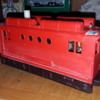I'm in the process of making a diesel out of a damaged 520. On the sides there are what looks like a spool with cable going out of it. I could see this on a crane, but why is it on the boxcab??
Replies sorted oldest to newest
Because on the real 520, owned by a mining company in Chile, There was a reel of wire that was a heavy duty extension cord that was used where overhead wires was unpractical to use.
Chuck Sartor posted:Because on the real 520, owned my a mining company in Chile, There was a reel of wire that was a heavy duty extension cord that was used where overhead wires was unpractical to use.
That makes sense! I guess I'll have to change it to a diesel hose.Ha.
Thanks for the help.
Chuck Sartor posted:Because on the real 520, owned by a mining company in Chile, There was a reel of wire that was a heavy duty extension cord that was used where overhead wires was unpractical to use.
That is an interesting detail, something I hadn't noticed before! Too bad Lionel didn't make it a real B-B loco.
Attachments
I think the reason why was to keep the price low - at around $13 to be exact in 1958.
Well, they were(are) still using them in these photos from 2000 in the nitrate mines (scroll down)
and here (Chilean boxcabs updated)
but, it seems they are different versions.
I found a weird text document listing the dissolution of shares of a Chilean exploration company, but it only had steamers.
So, no joy on confirming the reels. I would take Chuck's word on it.
Chuck Sartor posted:Because on the real 520, owned by a mining company in Chile, There was a reel of wire that was a heavy duty extension cord that was used where overhead wires was unpractical to use.
I wonder how often they were at the end of their rope (extension cord) ?.....LOL
Many electric locos had "jumper cables" for use where the engine might stall at gaps in the outside third rail, particularly in yard situations with complex trackwork.
One "lucky" crewman would have to hold the cable against the third rail until the engine pickup shoes reached power again. The engineer was supposed to reduce as much power draw as possible when contact was first made to reduce arcing. Same as when you plug in a device with a large current draw.
If the engineer were to have the engine in a higher notch, the arcing could be fatal or at least extremely unnerving to the crewman.
Jim
Jim Policastro posted:Many electric locos had "jumper cables" for use where the engine might stall at gaps in the outside third rail, particularly in yard situations with complex trackwork.
One "lucky" crewman would have to hold the cable against the third rail until the engine pickup shoes reached power again ...
I wouldn't touch that with a ten foot pole.
Attachments
Jim Policastro : Not needed on your layout because of the TELSA Power Plant. ![]()
Tony
Up on "The D & H Bridge Line"










